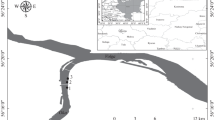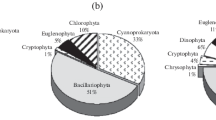Abstract
The species composition and taxonomic structure of the benthal algocenosis of the mouth of a large eutrophic–hypertrophic river in the period after the recession of a flood are characterized. In a comparative aspect, the features of these indicators in the communities of microphytobenthos of soft soils and the periphyton of stony substrates and aquatic macrophytes are determined. The dominant complexes of cenosis are identified and their spatial and substrate heterogeneity is determined. Relationships between floristic parameters (specific species richness and number of dominant community species) and some environmental factors (transparency, electrical conductivity, water temperature, and pH) are established.




Similar content being viewed by others
Notes
R Core Team. R: A language and environment or statistical computing. R Foundation for Statistical Computing, Vienna, 2020. https://www.R-project.org.
REFERENCES
Ács, É. and Kiss, K., Effects of the water discharge on periphyton abundance and diversity in a large river (River Danube, Hungary), Hydrobiologia, 1993, vol. 249, pp. 125–133.
Allan, J.D. and Castillo, M.M., Stream Ecology: Structure and Function of Running Waters, New York: Chapman and Hall, 2007. https://doi.org/10.1007/978-1-4020-5583-6
Belyaeva, P.G., Composition and structure of phytoperiphyton in the Sylva river (Perm territory), Bot. Zh., 2014, vol. 99, no. 8, pp. 903–916.
Bere, T. and Tundisi, J.G., Biological monitoring of lotic ecosystems: the role of diatoms, Braz. J. Biol., 2010, vol. 70, pp. 493–502.
Biggs, B.J.F. and Smith, R.A., Taxonomic richness of stream benthic algae: Effects of flood disturbance and nutrients, Limnol. Oceanogr., 2002, vol. 47, no. 4, pp. 1175–1186.
Boix, D., Garcia-Berthou, E., Gascon, S., et al., Response of community structure to sustained drought in Mediterranean rivers, J. Hydrol., 2010, vol. 383, nos. 1–2, pp. 135–146.
Chaïb, N. and Tison-Rosebery, J., Water quality assessment and application of the biological diatom index in the Kebir-East wadi, Algeria, Afr. J. Aquat. Sci., 2012, vol. 37, no. 1, pp. 59–69.
Dzhamalov, R.G., Nikanorov, A.M., Reshetnyak, O.S., et al., The waters of the Oka river basin: Chemical composition and sources of pollution, Voda Ekol., 2017, no. 3, pp. 114–132.
European Communities. European Communities Directive 2000/60/EC of the European Parliament and of the Council of 23 October 2000 establishing a framework for Community action in the field of water policy, Off. J. Eur. Communities, 2000, 43 (L327).
Guiry, M.D. and Guiry, G.M., AlgaeBase. World-wide electronic publication, National University of Ireland, Galway, 2019. https://www.algaebase.org.
Khedairia, T.M. and Okhapkin, A.G., Diatoms in algocenoses of bental as indicators of water quality in the mouth of the Oka River (Russia), Prints. Ekol., 2021, no. 3, pp. 99–115. https://doi.org/10.15393/j1.art.2021.11583
Komulainen, S.F., Metodicheskie rekomendatsii po izucheniyu fitoperifitona v malykh rekakh (Guidelines for the Study of Phytoperiphyton in Small Rivers), Petrozavodsk: Karel. Nauchn. Tsentr Ross. Akad. Nauk, 2003.
Komulainen, S.F., Fitoperifiton rek Respubliki Kareliya (Phytoperiphyton in rivers of Republic of Karelia), Bot. Zh., 2004, vol. 89, no. 3, pp. 18–35.
Komulainen, S.F., Structure and functioning of phytoperiphyton in small rivers of Eastern Fennoscandia, Doctoral (Biol.) Dissertation, Saint-Petersburg, 2005.
Komulainen, S.F., Phytoperiphyton of the Kem River and Its Tributaries (Republic of Karelia, Russia), Int. J. Algae, 2019, vol. 21, no. 2, pp. 123–136.
Laplace-Treyture, C., Peltre, M.C., Lambert, E., et al., Guide pratique de détermination des algues macroscopiques d’eau douce et de quelques organismes hétérotrophes, Les Éditions d’Irstea Bordeaux, Cestas, 2014.
Levadnaya, G.D., Mikrofitobentos reki Enisei (Microphytobenthos of the Yenisei River), Novosibirsk: Nauka, 1986.
Meteleva, N.Yu., Structure and productivity of phytoperiphyton in water bodies of the Upper Volga basin, Extended Abstract of Cand. (Biol.) Sci. Dissertation, 2013, Borok.
Meteleva, N.Yu. and Devyatkin, V.G., The structure and productivity of phytoperiphyton in reservoirs of the Upper Volga basin, Biol. Vnutr. Vod, 2005, no. 2, pp. 56–60.
Nevrova, E.L., Snigireva, A.A., Petrov, A.N., et al., Rukovodstvo po izucheniyu morskogo mikrofitobentosa i ego primeneniyu dlya kontrolya kachestva sredy (Guidelines for the Study of Marine Microphytobenthos and its Application for Environmental Quality Control), Sevastopol: N. Orianda, 2015.
Okhapkin, A.G., Species composition of phytoplankton as an indicator of living conditions in streams of different types, Bot. Zh., 1998, vol. 83, no. 9, pp. 1–13.
Okhapkin, A.G. and Khedairia, T., The diatoms as a component of bottom algocenoses in the mouth of the Oka River, Vopr. Sovrem. Algol., 2019, vol. 2, no. 20, pp. 60–63. http://algology.ru/1494
Okhapkin, A.G., Andriyanova, N.V., Maksimova, V.A., et al., Dynamics of hydrochemical composition in the lower reaches of the Oka River, Voda: Khim. Ekol., 2015, no. 5, p. 15.
Oksiyuk, O.P. and Davydov, O.A., Sanitary-hydrobiological characteristics of aquatic ecosystems in terms of microphytobenthos, Gidrobiol. Zh., 2011, vol. 47, no. 6, pp. 63–74.
Rivers of Europe, Netherlands: Elsevier, 2021.
Rusanov, A.G., Stanislavskaya, E.V., and Ács, É., Periphytic algal assemblages along environmental gradients in the rivers of the Lake Ladoga basin, Northwestern Russia: implication for the water quality assessment, Hydrobiologia, 2012, vol. 695, pp. 305–327.
Stanislavskaya, E.V., Struktura perifitona kak pokazatel' ekologicheskogo sostoyaniya pritokov Ladozhskogo ozera i reki Nevy, in Otsenka ekologicheskogo sostoyaniya rek basseina Ladozhskogo ozera po gidrokhimicheskim pokazatelyam i strukture gidrobiotsenozov (Evaluation of the Environmental State of Ladoga Lake Basin by Hydrochemical Characteristics and the Structure of Hydrobiocenoses), St.-Petersburg: Lema, 2006.
Tang, T., Niu, S.Q., and Dudgeon, D., Responses of epibenthic algal assemblages to water abstraction in Hong Kong streams, Hydrobiologia, 2013, vol. 703, pp. 225–237.
Trifonova, I.S., Ekologiya i suktsessiya ozernogo fitoplanktona (Ecology and Succession of Lake Phytoplankton), Leningrad: Nauka, 1990.
Tsarenko, P.M., Kratkii opredelitel' khlorokokkovykh vodoroslei Ukrainskoi SSSR (A Brief Guide to Chlorococcal Algae of the Ukrainian USSR), Kiev: Naukova Dumka, 1990.
Vladimirova, K.S., Fitomikrobentos Dnepra, ego vodokhranilishch i Dneprovsko-Bugskogo limana (Phytomicrobenthos of the Dnieper, its Reservoirs and the Dnieper-Bug Estuary), Kiev: Naukova Dumka, 1978.
Vodorosli. Spravochnik. (Seaweeds. Handbook), Kiev: Naukova Dumka, 1989.
Funding
This study was carried out as part of research of the Institute of Biology and Biomedicine of Lobachevsky University of Nizhny Novgorod (Study of the Structure and Dynamics of the Vegetation Cover of the Nizhny Novgorod Volga Region under the Conditions of Anthropogenic Transformation of the Territory and Climate Change, 34.29.35, 2019–2023).
Author information
Authors and Affiliations
Corresponding author
Ethics declarations
Conflict of interests. The authors declare that they have no conflicts of interest.
Statement on the welfare of animals. This article does not contain any studies involving animals or human participants performed by any of the authors.
Additional information
Translated by V. Mittova
Abbreviations: IT, intraspecific taxon; Elect., electrical conductivity; S, number of species in the sample; Sd, number of dominant community species; Temp, water temperature.
Rights and permissions
About this article
Cite this article
Khedairia, T., Okhapkin, A.G. & Fukina, D.G. Composition and Structure of Benthal Algocenoses of a Large Eutrophic River: I. Taxonomic Characteristics and Dominant Species of Communities (Oka River, Russia). Inland Water Biol 15, 555–565 (2022). https://doi.org/10.1134/S1995082922050121
Received:
Revised:
Accepted:
Published:
Issue Date:
DOI: https://doi.org/10.1134/S1995082922050121




